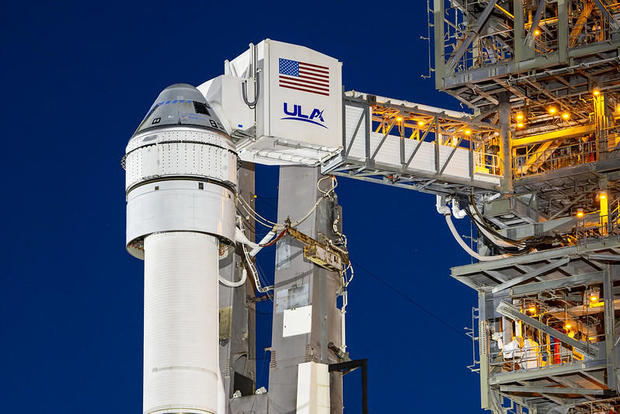
Booster valve glitch derails first crewed launch of Boeing’s Starliner spacecraft
An Atlas 5 rocket carrying astronauts for the first time was fueled for blastoff Monday night to boost Boeing’s long-delayed Starliner crew ferry ship into orbit for its first piloted test flight. But trouble with a valve in the rocket’s upper stage forced mission managers to order a scrub just two hours before takeoff.
It was a frustrating disappointment for commander Barry “Butch” Wilmore and co-pilot Sunita Williams, who were in the process of strapping in for launch when the scrub was announced. The moment brought to mind one of Wilmore’s favorite sayings, “You’d rather be on the ground wishing you were in space than in space and wishing you were on the ground.”
NASA said in a blog post early Tuesday that the launch will be delayed until at least Friday “to complete data analysis on a pressure regulation valve on the liquid oxygen tank of the Atlas 54 rocket’s Centaur upper stage and determine whether it is necessary to replace the valve.”
Axiom Space and a purely commercial, two-man, two-woman trip to low-Earth orbit paid for by billionaire pilot and businessman Jared Isaacman. In all, 50 people have flown to orbit aboard Crew Dragons.
It’s been a different story for Boeing’s Starliner.
During an initial unpiloted test flight in December 2019, a software error prevented the ship’s flight computer from loading the correct launch time from its counterpart aboard the Atlas 5.
United Launch Alliance
As a result, a required orbit insertion burn did not happen on time and because of unrelated communications issues, flight controllers were unable to regain control in time to press ahead with a space station rendezvous.
The software problems were addressed after the Starliner’s landing, along with a variety of other issues that came to light in a post-flight review. Boeing opted to carry out a second test flight, at its own expense, but the company ran into into stuck propulsion system valves in the Starliner’s service module. Engineers were unable to resolve the problem and the capsule was taken off its Atlas 5 and hauled back to its processing facility for troubleshooting.
Engineers eventually traced the problem to moisture, presumably from high humidity and torrential rain after rollout to the pad, that chemically reacted with thruster propellant to form corrosion. The corrosion prevented the valves from opening on command.
To clear the way for launch the following May, the valves in a new service module were replaced and the system was modified to prevent water intrusion on the launch pad. The second Starliner test flight in May 2022 was a success, docking at the space station as planned and returning to Earth with a pinpoint landing.
But in the wake of the flight, engineers discovered fresh problems: trouble with parachute harness connectors and concern about protective tape wrapped around wiring that could catch fire in a short circuit.
Work to correct those issues pushed the first crewed flight from 2023 to 2024. When all was said and done, Boeing spent more than $1 billion of its own money to pay for the additional test flight and corrective actions.
More
More
Source: cbsnews.com